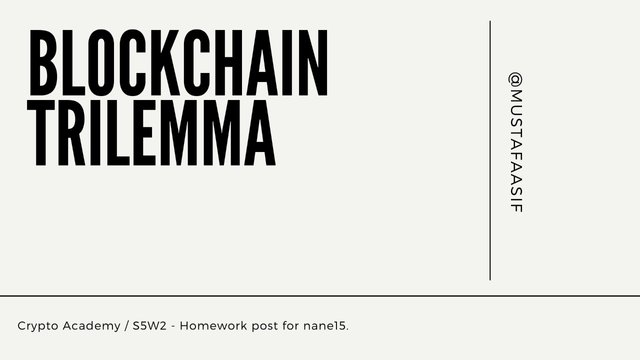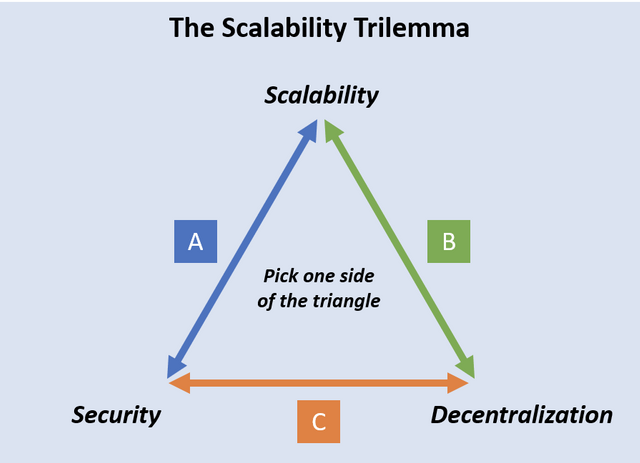Blockchain Trilemma - Crypto Academy / S5W2 - Homework post for nane15
Good day cryptocurrency aficionados! Professor @nane15 is back with an intriguing presentation regarding blockchain technology for week 2 of Steemit Crypto Academy season 5. I have read the presentation to the best of my ability, and this is my response to the post-lecture homework assignment. Let's get started.


Explain in your own words what the Blockchain Trilemma is?
The introduction of blockchain technology has resulted in major changes in a wide range of activities. Through the use of a public ledger (blockchain), which is made up of dispersed nodes all over the world, it has enabled the exchange of monetary assets and information more transparent and safe. We can now conduct many things both online and offline in a decentralized manner, without the involvement of any middleman or centralized authority, thanks to the blockchain network. The blockchain has been shown to be a more efficient and cost-effective method of disseminating information globally. The use of cryptocurrencies is the most common application of blockchain technology. The financial world has been decentralized as a result of this.
When it comes to how they store, execute, or analyze information, blockchain technology, like any other thing in the world, confronts some obstacles. If these issues are resolved, I believe the blockchain will gain widespread acceptance around the world, and people will turn away from centralized data management to embrace the blockchain network. Despite the fact that blockchain technology is evolving at a breakneck pace, the blockchain network currently has three distinct characteristics. The "blockchain trilemma" is a problem that arises when these three features are combined. The blockchain trilemma is made up of three factors: scalability, decentralization, and security. Vitalik Buterin, the founder of Ethereum, came up with the concept of the blockchain trilemma. The word describes how difficult it is for a single network to exhibit all three primary traits simultaneously.
The Bitcoin and Ethereum blockchain networks are currently the most popular, and both attempt to address some of these difficulties through the use of distinct technology. The implementation of Proof of Work (PoW) on the Bitcoin network has made it a relatively secure and decentralized network, but it will be extremely difficult for the network to solve the blockchain trilemma because it lacks one of the main difficulties, scalability. Because of the POW consensus process, scalability is a major concern for the Bitcoin network, as miners must accomplish complex challenges before a block can be validated.
The Proof of Stake consensus process, like that of the Bitcoin network, lowers scalability difficulties, however it is not particularly scalable. Another aspect of the Blockchain trilemma that most POS networks face is decentralisation, as the POS consensus mechanism only empowers a small number of high-stakes participants to act as validators and validate transactions.
Newer blockchains have emerged, and the majority of them are dedicated to addressing these issues through the use of various technology. They use a variety of consensus procedures, and the bulk of them fall behind on a given problem.
They are having trouble maximizing all three main tasks at the same time without abandoning one. The Polcadot Network, Cardano Network, Solana Network, and many other systems are examples of such networks dedicated to resolving the blockchain trilimma issue. Most of these networks are extremely scalable and can process a large number of transactions in a fraction of a second, but a closer examination of their operations reveals that they often sacrifice one of the features in the name of scalability.
They use a variety of approaches to solve these problems on a daily basis, but based on their current status, I don't believe they have been resolved. To overcome them, they still require more development. I am confident that there are dedicated project teams out there working nonstop to come up with newer solutions to this problem.

Is the Blockchain Trilemma Really a Trilemma?
Trilema: Three things are considered trilema if they have been shown to be extremely difficult to happen at the same time. In the blockchain network, there is still room for improvement. With the emergence of blockchain networks, the majority of them are on the verge of overcoming the hurdles of cooperatively applying the three fundamental features to their networks. There is no evidence to back up the blockchain trilemma theory.
Even though no present blockchain network has fully solved the blockchain trillemma, I am confident that it can be solved. I believe it is simply a term coined to emphasize the significance of those three key features and how difficult it appears to be for them to coexist.

Define the following concepts in your own words: A. Decentralization B. Scalability C. Blockchain Security
Decentralization
The blockchain network is predicated on the principle of decentralization. Decentralization shifts decision-making power from a centralized power to the blockchain's dispersed networks. Everything on the blockchain is now transparent and secure thanks to decentralization. Blocks are created to allow peers to move funds without the interference of any public agency.
The blockchain is a distributed ledger, and all nodes linked to the network have access to the blockchain's historical data. Each of the interconnections serves as a point of reference for the others. If a single node's data has an error, the rest of the nodes can be used to fix it. This prevents any node from making changes to its data. The amount of nodes that verify blocks determines the speed with which transactions or blocks are validated. If the number is higher, reaching a consensus will take longer than if the number is lower. The many blockchain networks use techniques to enable network decentralization. Consensus mechanisms are what they're called, and the block validation is determined by which one is employed. The Proof of Work Consensus technique is used in the Bitcoin network to verify and generate blocks.
A block is validated using the POW if a miner solves a difficult puzzle. The created blocks are then used in transactions. The POS, on the other hand, has a group of people who are known as validators. The validators are the network's most powerful stakeholders, and they vote to confirm the generation of blocks. Although both consensus processes contribute to network independence, it is obvious that the Bitcoin network, which utilizes the POW consensus mechanism, is more adaptable than the Ethereum network, which uses the POS consensus mechanism.
Scalability
The capacity to scale blockchain technology is critical. When it comes to confirming transactions, a network's scalability is the performance of the network's speed. A network with great scalability can handle more transactions per second. A network's scalability is usually determined by the consensus technique used and the number of nodes necessary to validate blocks.
Proof of work on the bitcoin network takes roughly 10 minutes to verify a block, so it can only process about 6 times per second, but proof of stake blockchains can process over 1000 transactions per second. The majority of blockchain networks priorities scalability over decentralization. This trilema is exemplified by the EOS network. It can confirm over 4,000 transactions per second and is planning an update that will allow it to confirm millions of transactions per second, but the problem is that the network is focusing less on decentralization in order to boost its scalability.
Security
A blockchain network's security relates to how vulnerable it is to assaults. In the crypto realm, there have been numerous hacking scandals, all of which have been caused by a lack of security in some of the networks. In the blockchain, security is critical, and it should be prioritized in all crypto assets. Safety is mostly determined by the project's coding and the consensus protocol employed. There have been multiple cases of blockchain fraud as a result of source code tampering, implying that a project's source code should be kept private to avoid being altered. The consensus processes are also used by the various blockchain networks to determine how blocks are validated. The great security of blockchain technology is generally known. In the Bitcoin network, for example, a hacker must obtain 51 percent confirmation from other nodes before he may change data, which is exceedingly tough to achieve. Other networks forego security in favor of scale and decentralization, which you already know is a risky proposition.

Based on your knowledge, explain at least two viable solutions to the challenges posed by the Blockchain Trilemma
Professor Nane15 described layer 1 and layer 2 as the current ways to overcoming the blockchain trilemma dilemma, as per the lecture. I am confident that if those two techniques (therefore, layer 1 and layer 2 solutions) are properly executed, the blockchain trilemma will be resolved.
Layer One:
provides methods to improve the status of the main blockchain so that it can scale faster and more securely in a decentralized network. The layer one solutions employ a variety of techniques, including:
Improving the consensus mechanism.
The proof of work process is used by the three previous blockchains, Bitcoin, Ethereum, and Litecoin. They're completely decentralized and safe. The problem here is one of scalability. I am convinced that if they all progress from POW to POS, where validators on the network are chosen based on their stake and contribution to the network rather than validating through mining, they will be able to tackle the scalability problem while maintaining security and decentralization. This technique has been used by the Ethereum network, which is now upgrading to Ethereum 2.0, which uses the POS consensus process. This will allow the network to handle scale transactions while retaining security and decentralization.
Sharding:
There's also another approach to tackle the blockchain trilema problem. It entails dividing the blockchain into shards in order to conduct transactions in a distributed manner. This method will aid scalability without compromising security or decentralization.
The layer two solutions entail building child networks on top of the primary one to assist in the resolution of the parent blockchain issues. The following are examples of layer two solutions:
By hirachycally nesting the networks in a parent-child relationship, work will be transferred from the main blockchain to the child chain, allowing for better scalability, decentralization, and security on the main chain.
The dilemma of the blockchain trilemma could possibly be solved by constructing sidechains adjacent to the mainchains. The sidechains' transactions will be open to the public and will be used to verify transactions. They should be built in such a way that if a sidechain's security is compromised, it will not have a significant influence on the main chain. Security and decentralization will be the core focus of the main chain.
Building off-chain channels that can connect with the main chain will also aid in the resolution of this issue. As a result, the burden on the main blockchain will be reduced.

Conclusion
The decentralization of Blockchain is one of the most significant developments since its conception, however most Blockchain networks are still plagued by scalability concerns, despite efforts to ameliorate this through various technical solutions. Security has always been a key concern for Blockchain technology, however the use of some security management tools, as well as the decentralization of the Blockchain, have considerably aided in minimizing this, thank you professor.
Cc: @nane15
#nane15-s5week2 #cryptoacademy #club5050 #trilemma #blockchain #security #Pakistan

@steemcurator02
@steemcurator02